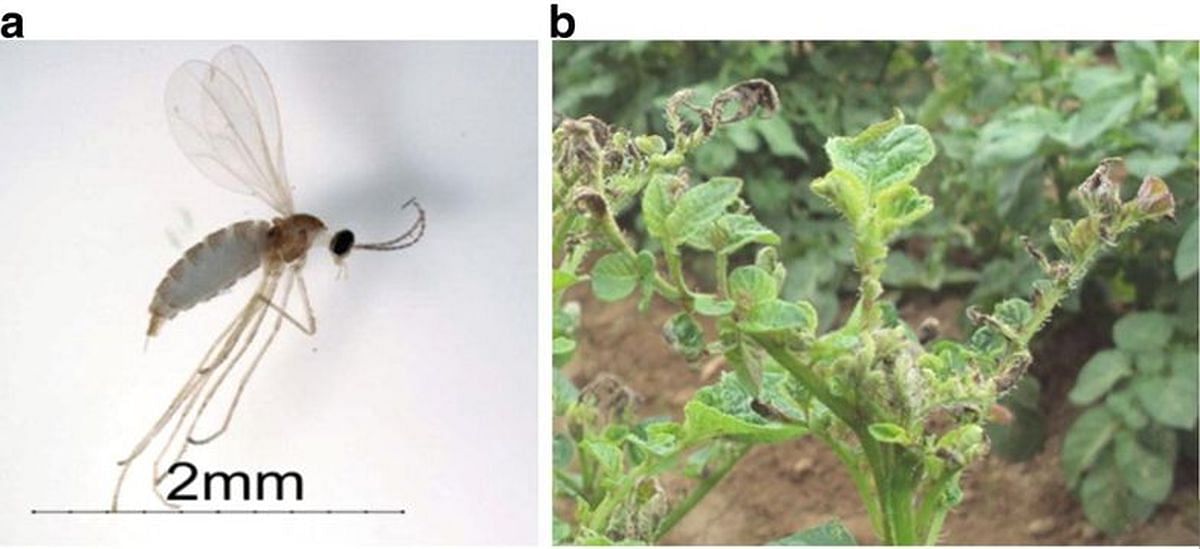Scientific description of the Bud Midge (2020)
Based on J. Kroschel. et al. (2020) Insect Pests Affecting Potatoes in Tropical, Subtropical, and Temperate Regions. In: Campos H., Ortiz O. (eds) The Potato Crop. Springer, Cham
The authors of this content are Jürgen Kroschel, Norma Mujica, Joshua Okonya, Andrei Alyokhin
Prodiplosis longifila Gagne (Diptera: Cecidomyiidae)
Distribution
Prodiplosis longifila is a polyphagous species only in the Americas (image below). Its origin is unknown. It occurs in North America (first reports from Florida in 1934 and from Virginia in 1990) and South America (Colombia, Peru, and Ecuador).
Some publications mention its presence in the 'West Indies' but detailed records for individual countries in the Caribbean are not available and a previous record for Jamaica is now considered to be a misidentification (EPPO 2015; Gagné 1986).

Prodiplosis longifila adult (a), larvae (b) and damage on potato sprouts (b). (Courtesy: CIP)
Host range
P. longifila is polyphagous and has been recorded from many plant species. However, economic damage is mainly reported on potato, tomato, pepper, asparagus and to a lesser extent on Tahiti lime (Citrus × aurantifolia (Christm.) Swingle, Citrus x latifolia (Yu. Tanaka) Tanaka).
Lists of host plants include important crops such as onion (Allium cepa L.), watermelon (Citrullus lanatus (Thunb.) Matsum. & Nakai), melon (Cucumis melo L.), cucumber (Cucumis sativum L.), artichoke (Cynara scolymus var. scolymus L.), soybean (Glycine max L.), alfalfa (Medicago sativa L.), beans (Phaseolus vulgaris L.), castor bean (Ricinus communis L.), and grape (Vitis vinifera L.).
Because the identity of the different populations of P. longifila has not yet been resolved, some records of hosts previously attributed to P. longifila may belong to another species (EPPO 2015).
Symptoms of infestation
P. longifila is minute in size, but extremely injurious under warm environmental conditions. The larva passes through three stages, with the first and second larval stages being the most harmful and causing damage to flowers and buds of different crops.
The larvae of P. longifila scrape the epidermal tissues of plant structures using piercing-sucking mouthparts.
Feeding on buds distorts growth points and results in winding stems and black appearance. It causes flower buds to fall and results in distorted fruit of low quality (EPPO 2015; Hernandez et al. 2015; Sarmiento 1997).
Impacts on production losses
P. longifila is one of the most important pests of Solanaceae crops (potatoes and other vegetables) and asparagus in the Neotropics causing yield losses >50%, if not controlled. It affects buds, flowers, and fruits, and causes severe damage to both open and protected crops.
During the first 50 days after plant emergence, the bud midge is a critical pest that affects plant growth by destroying both the terminal and lateral buds. However, infestations after flower initiation do not affect potato yields.
High temperatures favor the increase in midge population and hence crop damage, which could explain the reduced potato yields recorded during the El Niño phenomenon in Peru (EPPO 2015; Hernandez et al. 2015; Sarmiento 1997).
Methods of prevention and control
- Crop management.
Eggs and first instar larvae are in protected places (e.g. under the calyx) and are not visible with the naked eye (Gonzales-Bustamante 1996). Therefore, factors that favor vigorous potato plant growth (appropriate fertilization, healthy seed with vigorous sprouts, irrigation, and biostimulants) prevent pest damage by the rapid growth of buds and the exposure of larvae to dehydration and natural enemies.
Management practices to reduce infestation include optimal planting density, orientation of the furrows from east to west to favor insolation, elimination of broadleaf weeds, avoidance of susceptible crops, management of the planting season, and rotation with nonsusceptible crops (Mujica and Kroschel 2018). - Seed treatment.
Seed treatment with a systemic insecticide protects buds against initial bud midge infestation from emergence to formation of the first leaves and stems. This is a highly recommended practice since it ensures protection for a period of 35 days during a critical period of the crop, without affecting natural enemies (Mujica and Kroschel 2018). - Chemical control.
For a chemical control of this pest, the following should be considered: (a) dusting of sulfur powder on young plants to reduce initial infestation, (b) the use of translaminar or systemic insecticides, (c) dusting of dry powder insecticides at the soil or lower third of the plants, and (d) a combined control of larvae and adults with various active ingredients such as imidacloprid, dimethoate, mixtures of chlorpyrifos and alphacypermethrin, and vegetable and mineral oils (Castillo 2010).
Sulfur dust has repellent effects on the adults, but low toxicity to larvae. Treatments with sulfur are more effective in the late afternoon when adults become active and more exposed to the treatments. - Biological control.
The most commonly occurring biological control agents are egg and larva parasitoids of the genus Synopeas (Hym.: Platygasteridae), reaching parasitism of 16–20% (Hernández 2014). Important predators of third instar larvae and pupa are Chrysoperla asoralis Banks, Nabis capsiformis Germar, and Methacantus tenellus Stal. - Biopesticides.
In Peru, the entomopathogenic nematode Heterorhabditis sp. (native) showed 80% pathogenicity in larvae and pupae of P. longifila (Pacheco 2015). Mortality of P. longifila caused by Metarrhizium anisopliae, Baeuveria bassiana, Paecilomices fumosoroseus, and Verticillium lecanii under laboratory and greenhouse conditions was 75 and 69%, 71 and 73%, 62 and 50%, 59 and 44%, respectively (Reategui et al. 2009).
The application of entomopathogens in commercial fields of asparagus showed a reduction of P. longilifa pupae by 79.2% (B. bassiana), 70.8% (M. anisopliae), 30.4% (V. lecanii) (Castillo 2010).
